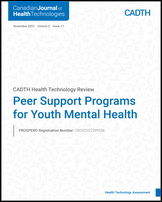| Conley et al. (2020)39 Associated: Hundert et al. (2021)40 RCT 3 university campuses in the US Funding not reported | 118 university students who self-identified as having a mental health illness or mental health challenge Participants were 82% female; mean age = 21.4 (SD = 6.6) years; primarily White (69%); 67% heterosexual; with clinical depression (59%) and/or anxiety (69%).b | Honest, Open, Proud–College (HOP-C), which aimed to reduce self-stigma about mental illness and help participants to make decisions about disclosure. Format: 3-week peer-led, manualized,52 in-person group program with weekly 2-hour lessons; 1 booster workshop 2 to 3 weeks later. Facilitators: students who identified as living with mental health concerns and completed a 2-day training. Comparator: Waitlist | Self-stigma (SSMIS-SF); stress and coping (Stigma Stress Scale); self-efficacy about disclosure (single item); depression symptoms (CES-D-10); anxiety symptoms (GAD-7). No safety outcomes reported. All outcomes assessed at baseline (T0), post-program (T1), post-booster (T2). 2-month follow-up (T3) reported in a population subset (n = 55).40 |
| Mulfinger et al. (2018)50 RCT Inpatient wards and outpatient psychiatry clinics in Germany Academic and foundation funding | 98 adolescents aged 13 to 18 years with at least 1 self-reported current axis I or axis II mental health concern and a moderate or severe level of disclosure-related distress. Participants were 69% female; mean age = 15.8 (SD = 1.1) years; 95% born in Germany; with clinical depression (59%) and/or anxiety (17%).b | Honest, Open, Proud (HOP) which aimed to reduce self-stigma about mental illness and help participants to make decisions about disclosure. Format: 3-week peer-led, manualized,52 in-person group program with weekly 2-hour lessons. Facilitators: young adults with lived experience of mental illness who had completed training and a young mental health professional. Comparator: TAU | Stigma stress (Stigma Stress Scale); HRQoL (KIDSCREEN-10); empowerment (Empowerment Scale); disclosure-related distress (4-item questionnaire); hopelessness (Beck Hopelessness Scale); self-stigma (ISMI-SF and SSMIS-SF); help-seeking (General Help-Seeking Questionnaire), recovery (Self-Identified Stage of Recovery Scale); secrecy and social withdrawal (Link Stigma Coping Orientation Scales); depressive symptoms (CES-D) All outcomes assessed at baseline (T0), post-program (T1), and at 6-months follow-up (T2). |
